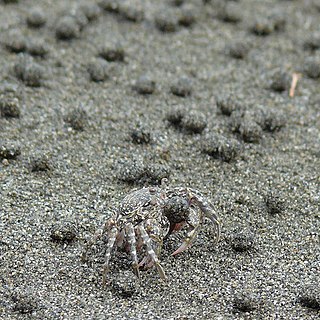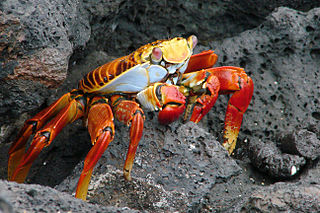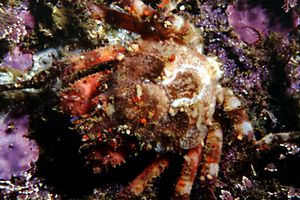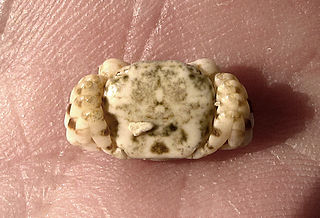
Xanthidae is a family of crabs known as gorilla crabs, mud crabs, pebble crabs or rubble crabs. Xanthid crabs are often brightly coloured and are highly poisonous, containing toxins which are not destroyed by cooking and for which no antidote is known. The toxins are similar to the tetrodotoxin and saxitoxin produced by puffer fish, and may be produced by bacteria in the genus Vibrio living in symbiosis with the crabs, mostly V. alginolyticus and V. parahaemolyticus.

Pinnotheres is a genus of crabs, including the pea crab. Many species formerly in Pinnotheres have been placed in new genera, such as Zaops ostreus, the oyster crab and Nepinnotheres novaezelandiae, the New Zealand pea crab. The species currently recognised in the genus Pinnotheres are:

The Ocypodoidea, or ocypoid crabs, are a superfamily of crabs, named after the genus Ocypode. It contains the following families:

Sand bubbler crabs are crabs of the genera Scopimera and Dotilla in the family Dotillidae. They are small crabs that live on sandy beaches in the tropical Indo-Pacific. They feed by filtering sand through their mouthparts, leaving behind balls of sand that are broken up by the incoming high tide.

The Grapsidae are a family of crabs known variously as marsh crabs, shore crabs, or talon crabs. The family has not been confirmed to form a monophyletic group and some taxa may belong in other families. They are found along the shore among rocks, in estuaries, marshes, and in some cases pelagic among drifting seaweeds and flotsam.

Macrophthalmus is a genus of crabs which are widespread across the Indo-Pacific. It contains the following species : Species in this genus are often referred to as sentinel crabs.

Petrolisthes is a genus of marine porcelain crabs, containing these extant species:

Menippidae is a family of crabs of the order Decapoda.

Ozius is a genus of crabs in the family Menippidae, containing the following species:

The Varunidae are a family of thoracotrematan crabs. The delimitation of this family, part of the taxonomically confusing Grapsoidea, is undergoing revision. For a long time, they were placed at the rank of subfamily in the Grapsidae, but they appear to be closest to Macropthalmus and the Mictyridae, which are usually placed in the Ocypodoidea. It may thus be better to merge the latter superfamily with the Grapsoidea, retaining the latter name as it is older.

Herbstia is a genus of crabs, containing the following eleven species:

Pilumnoidea is a superfamily of crabs, whose members were previously included in the Xanthoidea. The three families are unified by the free articulation of all the segments of the male crab's abdomen and by the form of the gonopods. The earliest fossils assigned to this group are of Eocene age.

Actumnus is a genus of crabs in the family Pilumnidae. Alongside the 28 extant species, it has a fossil record extending back into the Miocene.

Etisus is a genus of crabs, containing the following extant species:

Macropodia is a genus of crabs, belonging to the family Inachidae. It contains the following species:

Leucosiidae is a family of crabs containing three subfamilies and a number of genera incertae sedis:

Pilodius is a genus of crabs in the family Xanthidae, containing the following species:

Lachnopodus is a genus of crabs in the family Xanthidae, containing the following species:

Paraxanthias is a genus of crabs in the family Xanthidae, containing one exclusively fossil species and the following extant species:

Pseudograpsus is a genus of crabs, containing the following species:




















